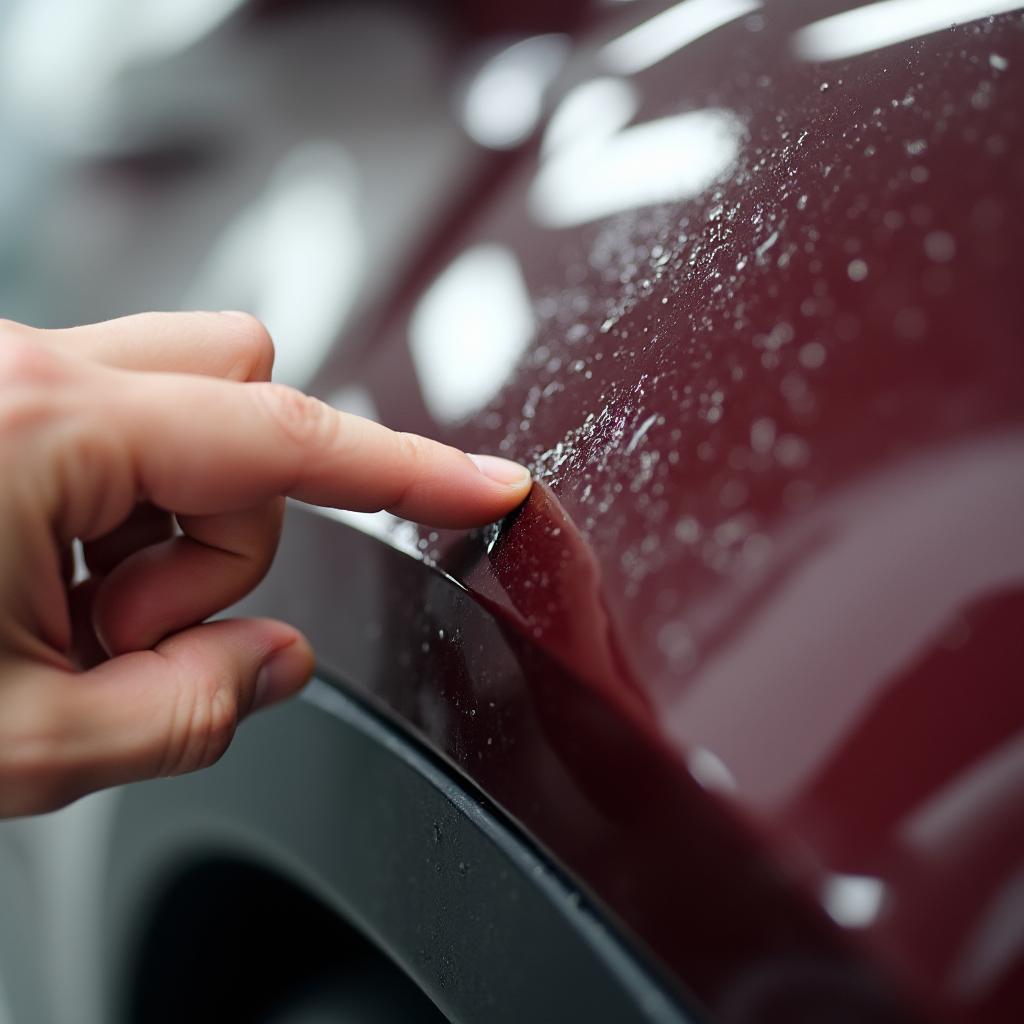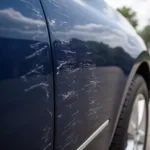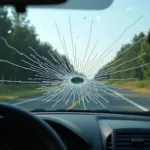Discovering a paint scratch on your car can be disheartening, but it’s a common issue that car owners often face. Fortunately, you don’t always need a costly trip to the auto body shop for minor scratches. With the right approach and a bit of effort, you can effectively repair paint scratches on your car yourself. This comprehensive guide will take you through the steps to assess the damage, gather the necessary materials, and restore your car’s finish to its former glory.
Assessing the Damage: A Crucial First Step
Before diving into the repair process, it’s vital to assess the severity of the scratches. This will determine the appropriate repair method and the materials you’ll need.
Types of Scratches:
- Clear Coat Scratches: These are the most superficial scratches affecting only the clear coat layer, the topmost protective layer of your car’s paint.
- Paint Scratches: These scratches go deeper, penetrating the clear coat and reaching the base coat, revealing the color beneath.
- Deep Scratches: The most severe type, these scratches cut through all paint layers, exposing the bare metal underneath, making them susceptible to rust.
Gathering Your Repair Arsenal
Once you’ve identified the type of scratch, gather the necessary materials:
For Clear Coat Scratches:
- Car wash soap
- Water
- Microfiber cloths
- Rubbing compound
- Polishing compound
For Paint Scratches:
- All of the above, plus:
- Touch-up paint (matching your car’s color code)
- Primer (if the scratch reached the metal)
- Clear coat pen or spray
For Deep Scratches:
- While minor deep scratches can be treated similarly to paint scratches, more severe cases may require professional attention.
How to Repair Clear Coat Scratches: A Step-by-Step Guide
Clear coat scratches can often be buffed out using a rubbing compound:
- Wash and Dry: Thoroughly wash and dry the scratched area to remove dirt and debris.
- Apply Rubbing Compound: Apply a small amount of rubbing compound to a clean microfiber cloth.
- Buff the Scratch: Gently rub the compound onto the scratch in a circular motion, applying slight pressure.
- Wipe and Inspect: Wipe away the residue with a clean microfiber cloth and inspect the scratch. If it’s still visible, repeat steps 2-4.
- Polish the Area: Once the scratch is gone, polish the area with a polishing compound to restore shine.
How to Repair Paint Scratches: A Detailed Approach
Repairing paint scratches requires a bit more attention:
- Clean and Prepare: Clean the area thoroughly, as with clear coat scratches.
- Apply Primer (if needed): If the scratch exposes bare metal, apply a thin coat of primer and let it dry completely.
- Apply Touch-up Paint: Using a fine-tipped brush or a touch-up pen, carefully apply thin coats of touch-up paint to the scratch. Allow each coat to dry before applying the next.
- Level the Surface: Once the paint dries, use fine-grit sandpaper (2000-grit or higher) to gently level the surface if necessary. Be careful not to sand through the surrounding clear coat.
- Apply Clear Coat: Apply a thin layer of clear coat over the touched-up area, extending slightly beyond the edges of the scratch. Let it dry completely.
- Sand and Polish: Once the clear coat dries, use fine-grit sandpaper to level any imperfections. Follow with polishing compound to blend the area and restore shine.
Preventing Future Scratches: Proactive Measures
Prevention is always better than cure. Here’s how you can minimize the risk of future scratches:
- Regular Washing: Frequent washing removes dirt and grime that can cause micro-scratches.
- Waxing: Applying wax provides a protective layer against minor abrasions.
- Covered Parking: Parking in a garage or under a carport minimizes exposure to the elements and accidental damage.
- Safe Distance: Maintain a safe distance from other vehicles while driving and parking.
- Protective Film: Consider applying paint protection film to vulnerable areas like the hood, bumpers, and mirrors.
Seeking Professional Help: When to Call the Experts
While DIY methods can effectively address minor scratches, certain situations warrant professional assistance:
- Extensive Damage: If the scratches are numerous, deep, or cover a large area.
- Rust Formation: If rust has already formed within the scratch.
- Structural Damage: If the scratch is accompanied by dents or other structural damage.
For these cases, it’s best to consult a reputable auto body repair shop for expert assessment and repair.
Conclusion
Repairing paint scratches on your car doesn’t have to be a daunting task. By following the steps outlined in this guide, you can restore your car’s finish to its former glory and maintain its aesthetic appeal for years to come. Remember, patience and attention to detail are key to achieving a seamless repair. If you’re unsure about any step or the severity of the damage, don’t hesitate to consult a professional. After all, a well-maintained car is a reflection of its owner.
FAQs: How to Repair Car Paint Scratches
Q1: Can I use nail polish to repair a car scratch?
While it might seem tempting, using nail polish is not recommended. Nail polish doesn’t adhere well to car paint and can cause further damage in the long run.
Q2: Can I use toothpaste to remove car scratches?
Toothpaste is often touted as a DIY scratch remover, but its effectiveness is limited to very minor surface imperfections. It won’t repair actual paint scratches.
Q3: How much does it cost to professionally repair a car scratch?
The cost varies depending on the severity and size of the scratch, as well as the type of repair needed. Minor scratch repairs can range from $50 to $200, while more extensive damage can cost several hundred dollars or more.
Common Scenarios for Repairing Paint Scratches:
Scenario 1: Key Scratches on Doors
Key scratches on car doors are unfortunately a common occurrence. You can use the touch-up paint method mentioned above to repair these scratches. Using masking tape around the scratched area will help you achieve a cleaner finish.
Scenario 2: Bumper Scuffs from Minor Accidents
Bumper scuffs are often superficial, affecting the clear coat. You can try using a rubbing compound and polishing compound to buff them out. If the scuffs are deeper, you might need to use touch-up paint.
Need Help with Your Car’s Paint?
Get expert advice and assistance with your car repair needs.
Contact us via WhatsApp: +1(641)206-8880 or Email: [email protected]. We’re here to help 24/7.
Looking for High-Quality Car Repair Tools?
Check out our selection of car auto scratching repair touch up paint pens for precise and easy touch-ups. For larger areas, explore our car paint repair pen for sale section.



